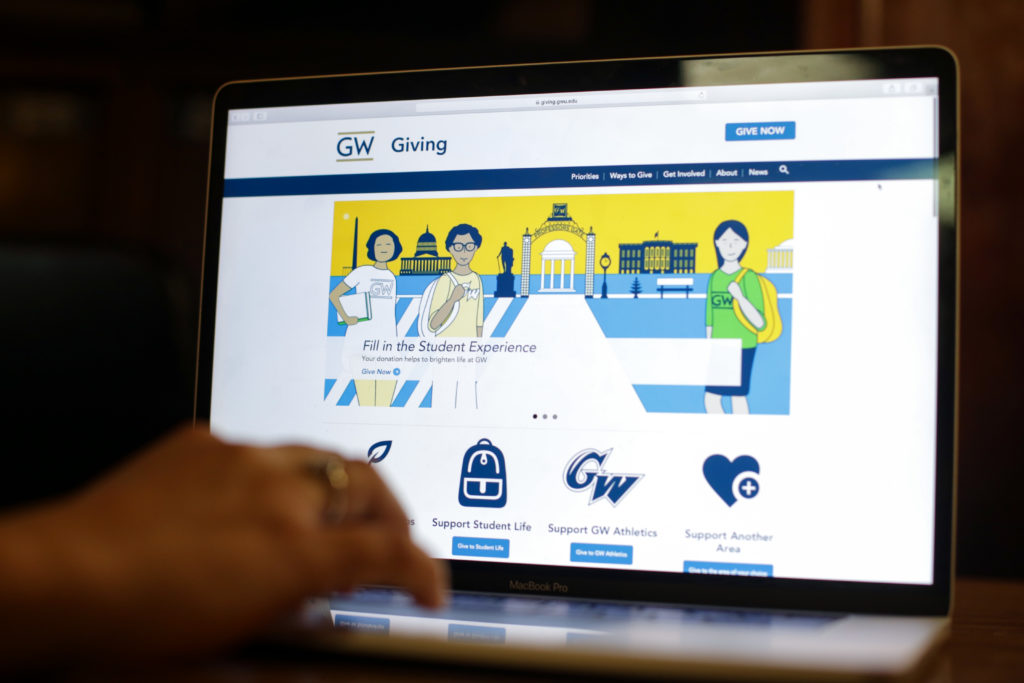Donors are increasingly giving money to GW through its website.
Over the past three fiscal years, donations made to the University online have increased by 56 percent to $2.6 million, according to a post on Executive Director of Marketing, Communications and Digital Matt Lindsay’s LinkedIn profile. Officials and experts said increased use of the internet and the ease of donating online contributed to the swelling population of online donors.
The fundraising office has outperformed “most” of its targets for online giving, according to the post.
University spokeswoman Lindsay Hamilton said online giving is currently a “small, but growing” percentage of overall giving to GW.
“This trend is true in higher education and nonprofits in general as donors become more comfortable with making gifts online and sustaining monthly giving becomes more popular,” she said.
She added the University’s online platform makes it easier for donors to give money to GW instead of using other methods like mail or phone to donate.
“We work to meet our constituents where they are today and make it as easy as possible for them to engage, volunteer and give back to GW,” she said.
She declined to say what percentage of donations from fiscal years 2013 to 2018 have come from online donations.
Fundraising experts said development offices have been forced to adapt to increases in online giving by hiring employees with backgrounds in online marketing and programming.
Elizabeth Nemme, a stewardship specialist at Auburn University in Alabama, said there has been an approximately 10 percent increase in online donations to her school every year over the past few years. She said young alumni feel more comfortable donating online as opposed to sending a check or making a donation over the phone.
“Recent grads, young alumni, they are used to the technology, so being able to do things efficiently from wherever they may be is a quick way for them to engage monetarily, quickly – their comfort with technology definitely helps that,” she said.
GW has tried to engage with more alumni in recent years. The proportion of alumni who donate to GW has dropped to roughly 9 percent over the past several years, ranking GW the lowest among its peer schools.
Nemme said it is important for fundraising offices to employ “technologically savvy” individuals and utilize software programs like CRM Advance by Ellucian and Raiser’s Edge by Blackbaud to keep track of donor history and use that information to make targeted efforts to increase giving to the University.
“It also allows us to see how our base is continuing to give to organizations and be able to make strategic changes to communicate, solicit and steward,” she said.
Officials announced last fall that they would use a new donation tracking service to stay in contact with donors. The University also promoted giving last semester by sending thank-you notes to donors.
Nemme added that as online giving has become more popular, fundraising offices have struggled to keep up with various data and payment card security standards. It is often expensive to update existing infrastructure, she said.
“Being able to balance all those requirements in an effort to take on your online giving is one of the biggest struggles a lot of institutions can have,” she said.
David Wishart, the assistant vice president for philanthropic engagement at Syracuse University, said his university has made efforts to make online giving easier, like offering an auto-fill function for donation forms similar to those available on popular websites like Amazon.
He said higher education’s prioritization of security makes it harder to meet expectations of ease and speed for online transaction. He said customers are used to the convenience of services like Venmo and PayPal, but higher education has not yet developed the security measures to use them.
Wishart added that while online donations have become more frequent, the largest proportion of donations still comes from traditional methods like sending a check or making a donation over the phone.
“Online giving will always be a great venue for frequency and total donor numbers, but they are still a long way to go before they catch up with dollar volume,” he said.
Wendy Kobler, the vice president of institutional advancement at Kentucky State University, said online donors are a new pool of donors that development offices should research and connect with to make sure they are maximizing the relationship.
“It’s going to bring more people into our mix, more awareness, so taking a look at those individuals, what’s motivated them to go online and give to your organization?” she said.





